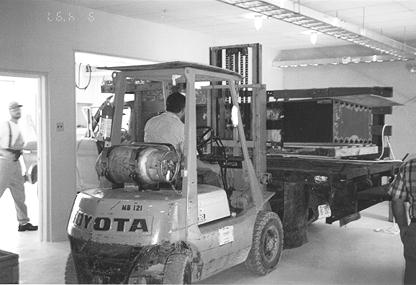[Next]
[Previous]
[Top]
NAIC/AO Newsletter, November 1997
Atmospheric Sciences Highlights
Craig Tepley
Moving House, the new Lidar Laboratory
We are ready to move into the Lidar Laboratory (LL) our two lidar systems
and begin to assemble the four telescopes that will collect and redirect the
scattered laser light from the sky into our receivers.

Our own instruments
should fill about half the lab at first, but other investigators are
knocking at our door anxious to stake their claim and carve out some of the
as yet extensive floor space for their instruments. With a fair number of
already planned experiments on the horizon, and the potential for new and
innovative studies that can take full advantage of these clustered
instruments, we expect some very exciting times ahead.
During this third quarter of 1997, only a small set of radar observations were possible. However, they clearly indicated a positive trend in our observational status, that is, a ramping-up in our ability to use the new systems as we approach full operations. Most of the observations were in support of the HF campaign that was described above by Mike Sulzer.
In addition to the HF studies, David Siskind and Daniel Meléndez, along with Qihou Zhou, conducted 3 days of electron density observations during August 12-14. This was a coordinated experiment with the flight of the CRISTA/MAHRSI (Cryogenic Infrared Spectrometers and Telescopes for the Atmosphere / Middle Atmosphere High Resolution Spectrograph Investigation) payload on board the space shuttle. The goal was to quantify the sources of D region ionization. Theory suggests that photoionization of nitric oxide (NO) by solar Lyman alpha is the dominant source of atmospheric ionization between 65 and 90 km. Thus, NO observations over the Caribbean region were made by MAHRSI on the same days as the ISR observations. Observations were made for 5 hours each on the morning of 8/12 and 8/13 and for 5 hours on the afternoon of the 14th. The observations should allow the categorization of the diurnal cycle of the D region electron density profile. These observations will be compared with a ion-chemical model that is constrained by the MAHRSI measurements of NO and measurements of the solar Lyman alpha flux from UARS (Upper Atmospheric Research Satellite).
The other atmospheric observations that took place between July and September were primarily optical. We continued our effort to provide a few measurements per month to add to our data base of neutral winds and airglow emissions of the thermosphere. We measured the atomic oxygen 630 nm emission with our photometers and Fabry-Perot interferometer during a few nights in July and August. During the dark moon period in late August and early September, we ran these instruments for eleven straight nights. This longer run was meant to satisfy two purposes. First, it was designed to test the automated airglow data taking features that we once used in the past and recently re-implemented. Next, this experiment provided a training exercise for our new atmospheric data analyst and observer, Eva Robles, who completed her first three months of apprenticeship.
Also in August, the sodium resonance lidar was operated for 4 nights around the peak of the Perseid meteor shower. Short (20 second) integrations were used in order to be able to see Na in the short-lived meteor trails above the background Na density. Data is still under analysis. An example of a suspect meteor trail is shown in Figure 5.

Figure 5. Meteor trail observations using sodium resonance lidar require a careful eye and patience. Even then, the interpretation is uncertain. Narrow, sharp layers which appear in several consecutive profiles are believed to be the result of a meteor which passed in the vicinity. The amount of time these trails stay in the beam depend upon their size, orientation, and speed. These plots shows a suspect meteor trail. It appears weakly during the 2nd 20 second profile, strengthens in the 3rd and 4th, and is gone by the 6th profile.
Another new person comes to us, this time from Scotland. Bryan MacPherson recently joined the atmospheric sciences group as our new "Space Weather" postdoc.
Two prominent investigators in the aeronomy field each visited Arecibo for their first time this quarter to discuss, among other things, possible future collaborations with Arecibo science staff. Ulf von Zahn, a lidar expert from the Institute of Atmospheric Physics at the Rostock University in Kuelilungsborn, Germany, presented his very fascinating results on direct lidar observations of meteor trails in the upper mesosphere. von Zahn and his group were able to see a large number of very short-lived meteor events by examining the returns from every laser pulse, 30 times a second. This work was done in three colors, that is, at the resonance fluorescence emissions of Fe, K, and Ca+, which are three prominent metals in meteors.
Another meteor researcher, Takuji Nakamura from the Radio Atmospheric Science Center of Kyoto University in Uji Japan, presented the latest meteor data that he and his group obtained with the MU Radar facility. Between von Zahn's earlier exchange and this one, it is very clear that there is a renewed interest in meteor research among the international aeronomy community. In addition, Nakamura discussed their group's long-term studies of atmospheric tides and planetary scale waves using multiple MF and meteor radars located in Japan, in Indonesia, and at Christmas Island in the Pacific. Their results seem to deviate somewhat from those of similar studies that Qihou Zhou of NAIC and David Fritts of the University of Colorado carried out using a pair of MF radars located in Aguadilla, PR and Barking Sands, HI. With Nakamura's visit, a new collaboration was established in an attempt to sort out these differences.
- Craig Tepley
-
NAIC/AO Newsletter, November 1997
[Next]
[Previous]
[Top] [Contents] [Index]

